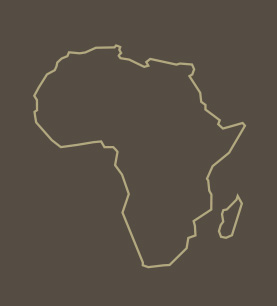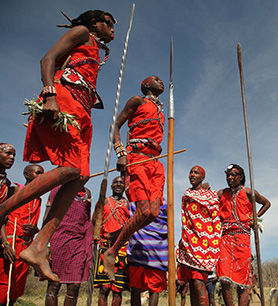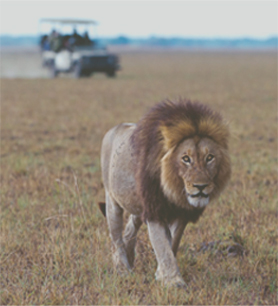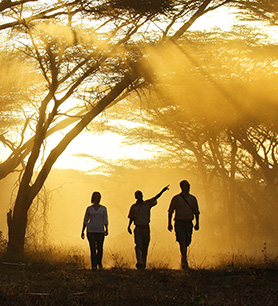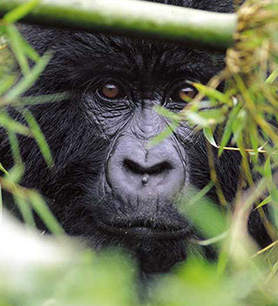Zambia – Walk on the wild side
Zambia is a landlocked country whose geography is shaped by its rivers, of which the most famous is its namesake, the Zambezi. Once a British colony under the name of Northern Rhodesia, Zambia became independent in 1964. Its economy is based on agriculture, copper mining and a growing tourism sector, with most of the people living around Lusaka and the towns of the Northern Copperbelt. This has resulted in huge, truly remote protected areas: 30% of the country is set aside for
wildlife with 20 national parks and 34 game management areas. In the South-East of the country the Zambezi, the fourth longest river in Africa, flows over the 1.7 km wide and 108 mt high Victoria Falls and then down through the Lower Zambezi valley into the Lake Kariba. Zambia’s untouched national parks feature diverse ecosystems and unique endemic species. Two of the Zambezi largest tributaries, the Kafue and the Luangwa, flow through the country and supply two spectacular national parks: the Kafue, Zambia’s oldest national park, and the South Luangwa National Park, home to one of the highest density of leopards in Africa. The northern region is covered by flood plains teeming with wildlife. Here the Liuwa Plains National Park is home to one of the great wildebeest migrations in Africa, while another migration, this time of millions of fruit bats, takes place in the community-run Kasanka National Park in the central province. A safari in Zambia is one of the most diverse, exclusive and challenging in Africa and definitely one to put in your bucket list if you are an outdoor activities enthusiast.
Uganda – The pearl of Africa
Uganda is a landlocked country lying on a fertile plateau in the heart of the Great Lakes region in East Africa. The geography of the country is incredibly varied. The western border is marked by the Albertine Rift Valley, where Rwenzori Mountains and volcanic lakes Albert and Edward are located. To the North the central plateau slopes down towards South Sudan in a semi-desert region, while the South is heavily influenced by Lake Victoria, Africa’s largest lake.
After independence in 1962 and the terrible years of dictatorship by Obote and Amin, Uganda has slowly recovered and opened to the world, becoming a more stable, dynamic and prosperous country. Nicknamed “the Pearl of Africa” by Winston Churchill because of its beauty, Uganda features a great variety of habitats and a very rich wildlife protected by 10 national parks. Amongst them the most famous is Bwindi Impenetrable National Park, located in the south-western corner of the country, whose ancient rainforest is home to almost half the world population of mountain gorillas. Further North in the Kibale Forest National Park it is possible to track no less than 13 primate species, including the chimpanzee. However Uganda is not just lush rainforests and exciting encounters with primates. In the scenic Queen Elizabeth National Park craters, gorges, rivers and lakes alternate with savannah plains home to elephants, buffalo, antelopes and tree-climbing lions. In the backdrop the Rwenzori Mountains range, the so-called “Mountains of the Moon”, stands out and it is a heaven for trekkers. The Victoria Nile and the majestic Murchison Falls enhance the picture of a primary destination in its own right, unique in Africa, that is not second to the nearby and more celebrated Kenya and Tanzania.
Rwanda – The land of a thousand hills
Located just South of the equator in East Africa, Rwanda is one of Africa’s smallest countries and it is landlocked. Its green and mountainous territory is quite highly elevated, with the lowest point standing above 900 mt. Rwanda’s western border is marked by Lake Kivu and the Virunga Mountains chain, that flanks the Albertine Rift Valley and consists of eight volcanoes of which five are within Rwanda. This includes also Mount Karisimbi, the country’s highest peak at 4,507 mt.
The centre of Rwanda is made up of rolling hills, while to the East there is a region of savannah and swamps. The country has rebuilt itself impressively after the horrors of the 1994 genocide, with some of the lowest incidences of corruption on the continent, the highest percentage of women in government in the world and the umuganda tradition, whereby Rwandans dedicate the third Saturday of every month to community service. Agriculture and a growing tourism industry are fuelling the country’s economic growth. In the renowned Volcanoes National Park, where the primatologist Dian Fossey studied mountain gorillas for almost twenty years, it is possible to observe at close quarters some habituated groups of these primates. Further South, the rainforests of Nyungwe are home to different primate species including chimpanzee. Rwanda is not just adventure, gorilla tracking and hiking in the mountains. The gorgeous beaches of Lake Kivu and the vibrant capital city Kigali with its cafe, restaurants and cultural spaces, complete the travel experience in Rwanda, adding some relaxation and sophistication to it.
Mozambique – Suddenly paradise
Facing the Indian Ocean, Mozambique stretches for over 2,500 km on the eastern coast of Southern Africa and shares its borders with Tanzania, Malawi, Zambia, Zimbabwe, South Africa and Swaziland. After 15 years of civil war the country has slowly started to recover and it is now emerging as one of the world’s finest beach destinations. Along the coast freshwater lagoons and mangrove forests alternate with long beaches fringed by palm trees.Two marine national parks, which protect the Bazaruto and Quirimbas archipelagos, protect the pristine coral reefs and the extraordinary marine wildlife, that include thousands of species such as the dugong and the whale shark. Here you can find also some of the best diving sites in the world. While the coast and the islands are wonderfully unspoilt and open to tourism, the interior is still wounded by the war and it is a destination for few visitors. In particular natural reserves such as Gorongosa National Park and Niassa Game Reserve have been badly damaged by conflicts and poaching. Conservation and wildlife reintroduction projects are currently taking place to bring these areas back to their splendour. Being a Portuguese colony for almost five hundred years, Mozambique is also rich in history and culture with churches, forts and trading posts built from the XVI century. The old buildings of Ibo Island, in the Quirimbas Archipelago, and of the beautiful Ilha de Moçambique, are a must-see. Mozambique is a unique beach destination, colourful and vibrant, where relax does not end in itself, but feeds on the culture of the place and is enlightened by the smiles of the people.
Malawi – The warm heart of Africa
Malawi is a small landlocked country stretching for about 900 km along the line of the Rift Valley and it is dominated by the namesake lake, making up much of the country’s eastern border with Tanzania and Mozambique. It is a densely populated country, with productive land and an economy heavily based on agriculture, which supports over 80% of the population. Originally known as Nyasaland, in 1891 it was colonized by the British.In 1964 it became independent with the name Malawi, while democracy was established only thirty years later, in 1994. The physical and cultural backbone of the country is Lake Malawi, the third largest in Africa, covering an area of about 29,000 km² and hosting the greatest variety of freshwater fish species in the world. The North part of the country features great highlands, the most magnificent of all being the Nyika Plateau, towering to 2,500 mt. Beside the unique landscape, Nyika is Malawi’s largest national park, home to big herds of roan and eland antelope. Blantyre, the commercial capital, and Zomba, the old colonial capital before Lilongwe, are in the South of Malawi, the most populated and developed part of the country. The region is dominated by the Shire River valley and by Mount Mulanje, the highest peak of Malawi. The Shire Valley hosts some beautiful parks and wildlife reserves such as the Liwonde National Park, Malawi’s premier game park, and the Majete Wildlife Reserve, which has been repopulated and became a “Big Five” destination. Malawi is a small gem in the heart of Africa offering a complete and incredibly varied travel experience, away from the crowds and enriched by the warm hospitality of the people.
Zimbabwe – A world of wonders
Expanding between the Zambezi River to the North and the Limpopo River to the South, Zimbabwe is a land-locked country sharing its borders with Botswana, Zambia, Mozambique and South Africa. The central part of the country consists of a plateau featuring savannah, tropical forests and mountains. To the North-East the Zambezi River forms the famous Victoria Falls, one of the “Seven Wonders of the World” and of the largest and most spectacular waterfalls on earth. Just South of it is Hwange National Park, the largest of the eight national parks, whose deserted habitat typical of the Kalahari is home to some of the country’s largest lion and elephant populations. To the North-East the Zambezi River keeps on flowing along the border between Zimbabwe and Zambia and through Lake Kariba, the biggest man-made lake in the world, renowned for its excellent fishing and wildlife teeming on its southern shores, protected in the Matusadona National Park. Further East, down the Zambezi, Mana Pools National Park is unique for canoe safaris in the river and walking safaris along its shoes, where it is possible to walk among wild animals even without a guide. In the remote south-eastern region, Gonarezhou National Park is famous for its beautiful landscapes and hosts one of Africa’s last stronghold of big tusked elephants. Hallmarks of ancient civilizations like the Great Zimbabwe ruins and the rock paintings at Matobo Hills add to these natural wonders, making Zimbabwe one of the most diverse and interesting countries in Africa, valued by tourist flows constantly growing also thanks to an economical and social situation more and more stable.
Tanzania – The show of nature
Located in East Africa within the Great Lakes region, Tanzania is one of the largest and most diverse countries on the African continent. To the East Tanzania meets the Indian Ocean along an 800 km coastline, which extends out to the world famous beaches of the Zanzibar Archipelago. The highest peak in Africa, Mount Kilimanjaro, is found in the densely forested and mountainous North-East region of the country. Further West the Ngorongoro Crater, the largest unbroken volcanic caldera in the world, towers over the grassy plains of the Serengeti National Park, home to the annual “Great Migration” of nearly two million wildebeest, zebra, Thomson’s gazelle and other antelopes. The three largest lakes in Africa are partly within Tanzania: Lake Victoria, Lake Nyasa and Lake Tanganyika, which is also the continent’s deepest lake. Tanzania has long attracted famous hunters, explorers and conservationists: Selous Game Reserve, now Nyerere National Park, is named after the acclaimed English hunter and explorer Sir Frederick Selous, while Gombe National Park was put in the spotlight by Dr. Jane Goodall and her revered work with the park’s chimpanzees. Tanzania’s natural variety is mirrored by a cultural diversity embracing 120 distinct tribes: from the iconic Maasai pastoralists of the Rift Valley to the Hadzabe hunter-gatherers of Lake Eyasi and the Arab-influenced Swahili of the coast. With such a rich mosaic of cultures, wildlife and protected areas, which cover about 40% of Tanzania’s land and include 19 national parks, the country continues to be the pinnacle of the ultimate African safari.
South Africa – A journey like no other
At the southernmost tip of Africa, surrounded by the Indian and Atlantic Oceans, South Africa shares its land borders with Mozambique, Zimbabwe, Botswana, Namibia and Swaziland and contains the Kingdom of Lesotho. After a recent history of ethnic segregation and exploitation due to the apartheid regime, in the last 24 years South Africa has been slowly transforming the past to develop multicultural diversity and build one of the most successful economies in Africa.The country is as diverse in its people and cultures as it is in its geography and wildlife. Its pluralistic makeup is reflected in the recognition of 11 official languages, while the ecosystems and landscapes vary from desert to sub-tropical forests, from white-sand beaches to extensive savannah, from the endemic fynbos to the Blyde River Canyon, the third largest in the world. South Africa offers incredible natural wonders: the abundant and varied wildlife of Kruger National Park, the spectacular oceanic ecosystem along the coasts of Cape Town and the Western Cape, the harsh but incredibly scenic landscapes of the Kalahari and Karoo deserts, the warm sea and beautiful rolling hills of Kwazulu-Natal. South Africa’s diversity makes it the ideal destination for an introductory trip to Southern Africa which combines different experiences: city life, outdoor sports, culinary tasting, beaches and wildlife.
Namibia – Land of contrasts and endless horizons
Namibia is a boundless country, sparsely populated and mostly untouched. Slightly more than two millions people inhabit an extension of 800,000 km². The backbone of the country is a long plateau more than 1,600 m high that declines towards the Kalahari Desert to the East and towards the Namib Desert to the West. Four national parks protect the fragile ecosystem of the Namib Desert, that runs for 1,600 km along the coast, where it meets the chilly waters of the Atlantic Ocean.Among these the Namib-Naukluft National Park, setting of the majestic red dunes of Sossusvlei, and the Skeleton Coast National Park with its solitary shores dotted with mysterious shipwrecks. To the South the earth cracks, forming the spectacular Fish River Canyon, while to the North the salt plains of the Etosha Pan, the throbbing heart of the Etosha National Park, glitter in the sun and desert elephants roam in the ancient valleys of Damaraland. The Caprivi Strip breaks the regular borders of the country and stretches into Angola, Zambia and Botswana, forming an oasis of lagoons and floodplains. Namibia is in fact teeming with wildlife: 4,000 species of plant, 650 species of bird and 80 species of mammal survive in often inhospitable environments, protected inside 11 national parks plus more than 70 conservancies and reserves. The desert fauna, the cultures of the Himba and the Bushmen, the rock paintings and geological formations of Damaraland, and the colonial architectures of Windhoek, Luderitz and Swakopmund complete the picture of an ancient land where opposites attract and coexist in a delicate, though perfect balance.
Kenya – The green hills of Africa
Kenya is a country with a complex geography that extends across the Equator and overlooks the Indian Ocean. West of the long coastal strip inland plateaus are divided from North to South by the Rift Valley, a massive geological formation that twenty million years ago has reshaped the landscape of Kenya. The basin of the Rift Valley is occupied by Lake Turkana and other alkaline lakes, while on either side several volcanic massifs arise including Mount Kenya, the second highest mountain in Africa after Kilimanjaro. Kenya features an incredible variety of ecosystems and a unique biodiversity, protected by a network of over 50 national parks and reserves such as the Maasai Mara National Reserve, the kingdom of the “Big Five” and the theatre of the great wildebeest migration. However, it’s in non-protected areas, which cover 90% of the territory of Kenya, where the toughest game for conservation is played. The most surprising results come from private conservancies such as those of Laikipia, where the numbers of wildlife are constantly growing. Inhabited by a variety of people equal to that of its territories, Kenya is home to more than 40 ethnic groups, including the Kikuyu, the Turkana and the Maasai, who in rural areas continue to live according to their traditions, in close communion with nature. In the last hundred years Kenya has attracted adventurers and explorers, such as Churchill, Roosevelt, Selous, Finch-Hatton, Blixen and Hemingway, charmed by its scenic landscapes and its extraordinary wildlife. Here, even today, you can relive the excitement of safari as it used to be once upon a time.
Utilizziamo i cookie per essere sicuri che tu possa avere la migliore esperienza sul nostro sito. Scopri di più nella nostra cookie policy Accept Privacy & Cookies Policy
